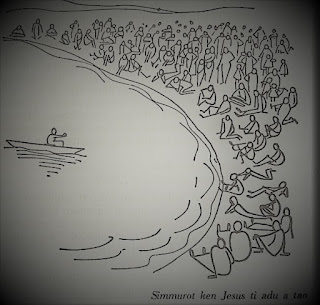PASYON ILOCANO
The Pasyon Ilocano consists of three forms. The first form is the Pasyon itself, said to be a translation of the Tagalog Pasyon Genesis or Pasyong Mahal a poetic retelling of the key events of the scripture from Creation to Resurrection. The Ilocano Pasyon is rarely chanted nowadays unlike the two other forms: the Sudario and the Leccio.
The Sudario (literally “handkerchief” in Latin; cf. Santa Veronica’s sudario), inculturation of the dungaw, the pre-colonial Ilocano dirge, consists of five lines of eight syllables per stanza. Every part has ten stanzas with the tenth as a two-line verse that summons a personified Jerusalem. It is sung soulfully—there is a “drawl,” a prolongation of a vowel sound such as “ah” to make the lament even more emphatic and mournful. Unlike the Tagalog Pasyon whose musical setting has adjusted to contemporary music, the original melody of the Sudario has endured and continues to be heard throughout the Lenten season especially during Good Friday before the Santo Entierro (the image of the dead Christ in supine position).
The Ilocano Leccio is a rendition of the Lamentations of Jeremiah in Latin (Vulgate), sung to the typical Ilocano "dung-aw" melody.
The Sasainnec (Book of Lamentations) in the Hebrew text of the Old Testament is an alphabetical acrostic poem. Each poem consists of twenty-two verses, with each verse commencing with a successive letter of the Hebrew alphabet. The Latin translation precedes each poem, spelling out these Hebrew letters. Thus, the Ilocano Leccio commences with a long yet impassioned singing of ALEPH, the first letter of the Hebrew alphabet.
The Leccio represents a local adaptation or inculturation of the "Tenebrae" (Ilocano “Tinieblas,” the morning prayer services during the Triduum (Holy Thursday, Good Friday, and Holy Saturday), which include the reading of the Lamentations of Jeremiah. It involves extinguishing candles one by one as Christ goes through his passion. At the ritual of the ritual, a loud noise is created to symbolize the earthquake following the death of the Messiah.
The Leccio in this recording is from Lamentations 3:1-9 and sung by members of the Men’s Choir of Tayum, Abra. Special thanks to the Ballena family for granting permission to use the recording.
[Image: Sto. Entierrio is owned by the Carino family, Gabriela Silang Gallery of Fine Arts, Tayum, Abra).
For those seeking further insights into the Book of Lamentations from a Filipino perspective, an excellent commentary is available by Pastor Federico Villanueva, titled Lamentations (Langham 2016).


Comments
Post a Comment